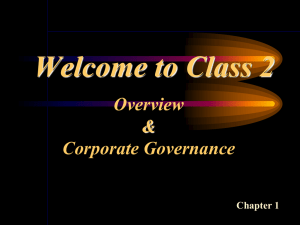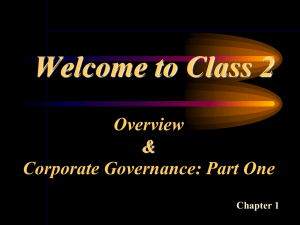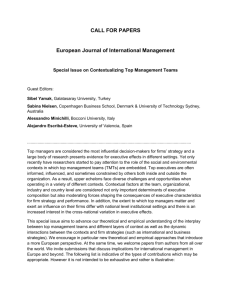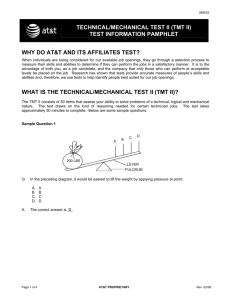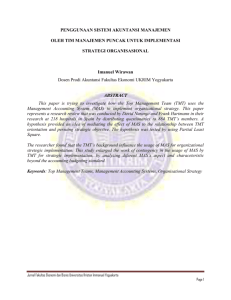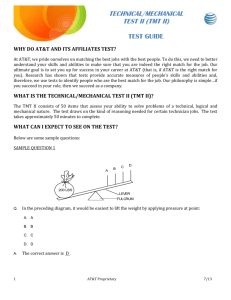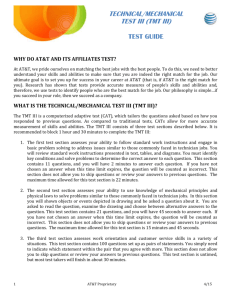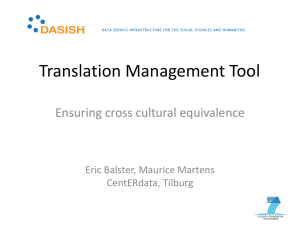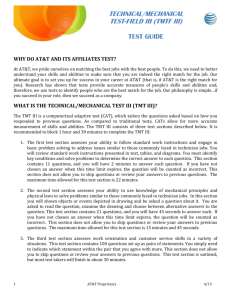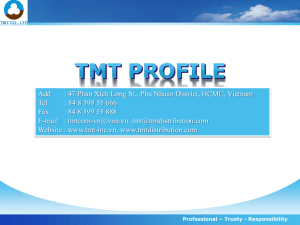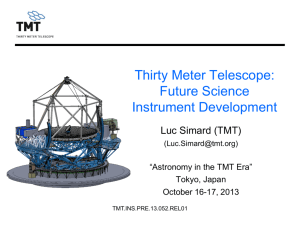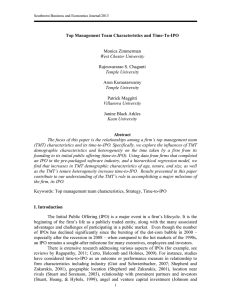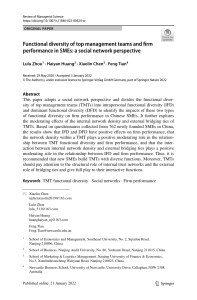Professor Lecture Notes.
advertisement
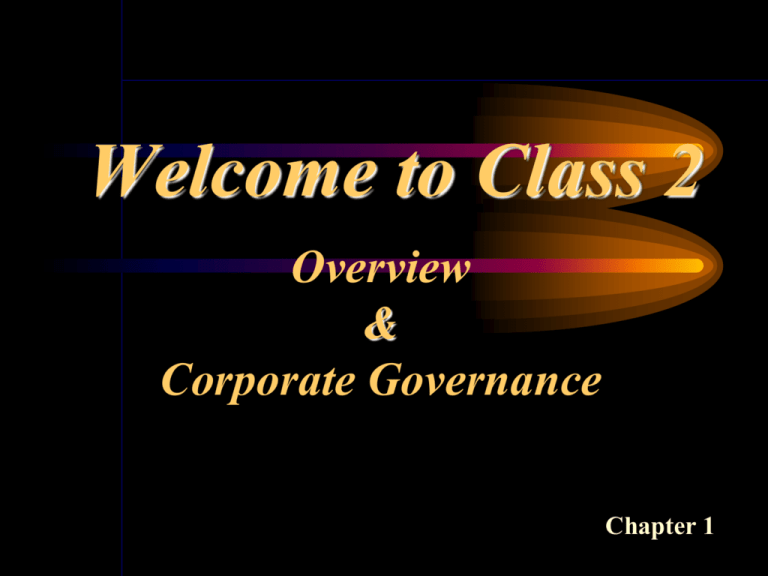
Welcome to Class 2 Overview & Corporate Governance Chapter 1 Overview of Course & Textbook Course is divided into: Concepts and Activities Management Research Strategy Evaluation The Management book presents TMT Competencies, Strategy Concepts, and Methods for Researching and Assessing Corporate Performance Book available only as an “E” book: Management Strategy & Performance Online: http://www.campus-hq.com/ Research, Analyze, and Report Raymond K. Van Ness 6th Edition The Management Textbook is divided into three distinct segments Governance & Nature of Strategy Nature of Corporate Performance Demystification of Financial Data; Measuring, Assessing, & Reporting Top Management Teams (TMT) (1) Introduction to Corporate Research (5) Stakeholder Perspective (9) Business Environments (2) Research Methodologies (6) Creating Value (3) Corporate Boards (4) Ch 1, 2, 3, 4 Financial Demystification (10) Performance Scorecard (11) Qualitative Research (7) Measurements & Meanings (12) Financial Research (8) Performance Scoring & Report Drafting (13) Formalizing The Performance Report (14) Ch 5, 6, 7, 8 Ch 9,10, 11,12, 13,14 Each Chapter addresses specific questions Chapter 1: Who is running the company and what should they know and do? Chapter 2: What is the business climate and what must firms do to compete successfully? Chapter 3: How do firms add value & whom must they satisfy? Chapter 4: What are the mechanisms for overseeing TMT behavior and decision-making? Chapter 5: What is corporate research? Chapter 6: How can “we” do corporate research and why is it important? Chapter 7: How do “we” research the social side of performance & TMT’s strategic planning? Chapter 8: What do “we” need to know to investigate financial performance? Each Chapter addresses specific questions Chapter 9: Why do different people assess a firm’s performance differently? Chapter 10: Why are financial reports confusing and how can they be made understandable? Chapter 11: What is a functional tool for standardizing financial reports? Chapter 12: What do all the ratios mean and how can they be used effectively? Chapter 13: What is an easy and effective way of quantifying a firm’s performance? Chapter 14: What is an easy and effective way for reporting a firm’s performance? Each person must purchase their own individual online text & analysis software. You MUST have your own copy. Management Strategy & Performance Research, Analyze, and Report Raymond K. Van Ness 6th Edition Note: A security code will be provided by the publisher that MUST be included on your final semester project. The PSC software will be provided by the publisher when you acquire your online textbook package. A Closer look …. Corporate Governance Corporate Governance Corporate Governance 1. Consists of the processes, customs, policies, and procedures of a firm as well as the governing body that is responsible for its direction, management, and control. 2. Should balance the interests of: Customers, employees, managers, owners, and other stakeholders GOVERNING BODY consists of: 1. Stockholders 2. Management 3. Board of Directors Corporate Governance Leadership Processes Procedures Corporate Governance Policies Customs Governance: Anchor Points • VISION • MISSION • STRATEGY Vision VMS Strategy Mission Vision and Mission The Vision and Mission statements are anchors that: 1. 2. 3. 4. Communicate "what a firm wants to be" Communicate "what the firm does.“ Provide a stable identity analogous to a nation's constitution. Express a firm’s values and beliefs about its responsibility as a corporate citizen. 5. Clarify the purpose of the organization, help employees bond with the firm, and set a context for understanding management decisions and actions. Vision A Vision Statement should be inspiring and highlight a firm's aspirations and values. It should be uplifting and evoke positive emotions. It defines "what a firm wants to be." Mission The firm's mission statement clarifies where the firm will focus its attention and highlights its core values and beliefs. It may emphasize how and why the company plans to compete in specific areas. In brief, it clarifies "what a firm does." Strategy A firm's strategy is the TMTs "how to" plan for fulfilling the organization's mission and accomplishing its goals and objectives. The strategic plan is an detailed document outlining specific courses of action each with precision and an exact timeline. It is the map for achieving competitiveness. It emphasizes its Performance Objectives Performance Objectives TMTs guide their firms to the achievement of Performance Objectives by: Motivating the firm's employees Energizing & leveraging value-producing resources Developing basic, core, and distinctive competencies Performance Objective Ladder 1 2 3 • Strategic Competitiveness (Initial Competitive Advantage) • Sustainable Competitive Advantage • Recurrent Above Average Returns 1. Strategic Competitiveness Strategic Competitiveness is the result of unique business competencies that enable the firm to perform activities more effectively and efficiently than rivals. It is the first rung on the performance objective ladder It means the firm is able to earn disproportionally higher profits than its competitors. It suggests a firm has a competitive advantage over rival firms. 2. Sustainable Competitive Advantage Achieving a Sustainable Competitive Advantage means a firm has discovered a method for continuously performing its value generating activities more effectively and efficiently than its rivals. Sustainable competitive advantage is the second rung on the competitive ladder – it means "commercial staying power." 3. Recurrent Above Average Returns [RAAR] Above Average Returns are desirable to investors since they indicate the firm is a better than "average" investment. Above average returns are those that exceed what investors would normally expect to achieve on similar risk investments. The ultimate objective is to implement a strategy that enables these AAR to be recurrent. RAAR is the third rung on the performance objective ladder. Recurrent Above Average Returns are earned only by firms that have ACHIEVED and SUSTAINED a competitive advantage for an extended period of time. Remember: Sustainable = Recurrent Potential Sustained = Recurrent Achievements Above Average Returns & Strategic Levels Competitive Advantage, Above Average Returns, and Strategic Levels BUSINESS level: Competitive Advantage and above average returns at the “business” strategic level = high profits + satisfied customers. CONGLOMERATE level: Competitive Advantage and Above Average Returns at the “conglomerate” strategic level = successful & synergistic subsidiary businesses. (Portfolio of businesses) Conglomerate level strategy is also called corporate level strategy Performance: Theoretical Models Performance: Theoretical Models Conflicting Theories about The Primary Factors Dictating a Firm’s Success or Failure In achieving RAAR Is Performance primarily dependent upon a firm’s competencies and leadership? Or Is Performance primarily related to the industry in which a firm competes? The conflicting ideas are categorized as: (1) The Resource-based View, and (2) The Industry/Organizational View (1) Resource-based View (R/B Model) Assumptions of the R/B model: 1. Performance objectives are dictated by the firm’s unique resources and capabilities 2. The internal environment: A firm’s physical, financial, intangible, intellectual, and leadership resources will determine the degree of its success. In other words, it is not so much the industry that dictates the firm’s ability to produce above average returns as it is the ability to compete within that industry. (2) Industry/Organizational View (I/O Model) Assumptions of the I/O model: 1. External environment imposes pressures and constraints that determine strategies leading to above-average returns 2. Most firms competing in an industry control similar strategically relevant resources and pursue similar strategies 3. Resources used to implement strategies are highly mobile across firms 4. Although a firm’s physical, financial, intangible, intellectual, and leadership resources are important, it is primarily the industry in which it competes that will determine the degree of its success In other words, it is the industry that dictates the firm’s ability to produce above average returns. TMT – Competencies From the R/B Model to the I/O Model – Competent TMTs are essential Take a 5 minute break Skills Knowledge Ability Managerial Competence Literacy = Knowledge [Understand Concepts] Managerial literacy at the TMT level suggests a highly refined knowledge of managing people and strategies. TMT literacy encompasses knowledge of contemporary theories and practices for the effective deployment of intellectual, physical, and financial resources. TMTs are expected to have an extensive knowledge of corporate finance and accounting. 8 Specific spheres of business literacy • • • • • (1) Human resources (2) Corporate cultures (3) Industry-specific customs, practices, and procedures (4) Accounting and finance (5) Techniques for the effective utilization of corporate resources • (6) Systems for assessing progress (qualitative and financial performance monitors) • (7) Analysis methods (feedback loops) • (8) Tactical and Strategic planning Manage = Skills [Can Apply Concepts] Management skills-set includes: 1. Technical know-how 2. Communication Skills 3. Implementation Skills 4. Interpersonal Skills 5. Persuasion Skills The TMT must be able to apply what they know. Skills of Persuasion Management must have: The right knowledge Skills to apply that knowledge Skill to persuade others to follow their leadership Aristotle, the Greek philosopher, identified three methods of persuasion and good managers have mastered each: • Logos = Persuasion by Reasoning • Pathos = Persuasion by Emotional Appeal • Ethos = Persuasion by Character Logos Ethos Pathos Ability = Critical Thinking [Can Apply Concepts with great expertise] Critical thinking requires: Intellectual discipline Elimination of bias Visualizing situations from a variety of perspectives Reflecting, reasoning, and communicating conclusions in clear and logical manner. TMT – Responsibilities Embrace the organization's vision and mission Meticulously analyze the internal and external environments Set realistic goals and objectives Craft, implement, and manage tactics and strategies for the continuous achievement of above average returns The TMT must expertly execute 5 Strategic Management Activities TMT Strategic Management Activities 1. (SWOT) Analyze the (internal & external) environments to assess the firm’s a) b) c) d) Strengths Weaknesses Opportunities Threats 1. Scanning 2. Monitoring 3. Gathering Competitive Intelligence 2. (Strategic Intent) Reaffirm or reestablish short & long-term goals and objectives 3. (Strategy Formulation) Translate goals and objectives into tactical & strategic action plans 4. (Strategy Implementation) Communicate and activate the tactical and strategic plans 5. (Strategy Management) Assess interim successes & failures and adjust course as conditions merit Core Operating Levels Strategies are significantly different at different core operating levels • Business Level Models (1st Level) versus • Conglomerate Level (2nd Level) Core Operating Models 1. First-level Corporations (business-level model) Value creating and competitive advantage through: Marketing products and/or services. 2. Second-level Corporations (conglomerate-level model) Value creating and competitive advantage through: Management of a portfolio of subsidiary companies. Business-level model (First-level) Achieving sustainable competitive advantage means: Offering products and/or services that are distinctive* that also provide profit maximization opportunities for the firm. Four methods of achieving DISTINCTIVENESS: 1. Uniqueness of product/service 2. Added or special components 3. Lower cost levels 4. Preferential delivery DISTINCTIVENESS: 1. Provides customers a motive to purchase from a specific firm 2. Proves difficult for competitors to duplicate or imitate Business level strategic formulation is guided by the firm’s competitive model. Competitive Models: 1. Low-Cost leadership (considered as least expensive or best value provider) 2. Differentiation (considered as offering a unique products or services) 3. Narrow Market Catering [NMC] (providing a products or services not easily available elsewhere) (often referred to as niche or focus strategy) Conglomerate-level model (Second-level) Achieving sustainable competitive advantage at the conglomerate-level means: Creating a portfolio of synergistic businesses Subsidiary companies are beneficial when they provide synergistic benefits such as: (1) (2) (3) (4) Shared knowledge Operating systems Facilities Contact networks, etc. Conglomerate-level Strategies Conglomerate-level strategists have options such as: 1. Joint ventures 2. Corporate partnering 3. Other types of collaborative activities However, the most common strategy involves acquisitions and/or divestitures of operating companies. The strategists can change the basic composition of the parent company simply by diversifying into new lines of business. Corporate diversifications through acquisitions are divided into: 1. Related Diversifications (Those that are closely related to companies currently in the portfolio) [frequent successes] 2. Unrelated Diversifications (Those that are significantly different from previously owned subsidiaries) [frequent failures] End Corporate Governance Homework: (1) Read Chapter 2 in your online textbook (2) Elect team officers: President, VP, Secretary (3) Study online lecture notes!!!! Point of emphasis: 1. Core Operating Models are Business-level and Conglomerate-level 2. Competitive Models relate to Business-level companies and include strategies such as cost leadership, differentiation, and niche marketing 3. Goals are a general description of a performance aim 4. Objectives are the specific target within a goal or set of goals.
